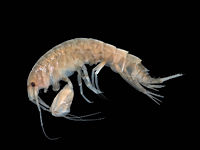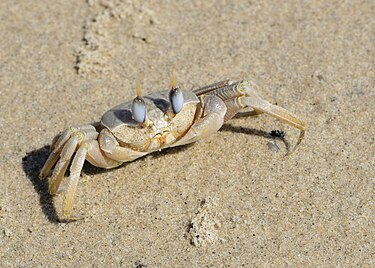The Crustaceans Portal Crustaceans are a group of arthropods that are a part of the subphylum Crustacea ( /krəˈsteɪʃə/), a large, diverse group of mainly aquatic arthropods including decapods ( shrimps, prawns, crabs, lobsters and crayfish), seed shrimp, branchiopods, fish lice, krill, remipedes, isopods, barnacles, copepods, opossum shrimps, amphipods and mantis shrimp. The crustacean group can be treated as a subphylum under the clade Mandibulata. It is now well accepted that the hexapods ( insects and entognathans) emerged deep in the Crustacean group, with the completed group referred to as Pancrustacea. The three classes Cephalocarida, Branchiopoda and Remipedia are more closely related to the hexapods than they are to any of the other crustaceans ( oligostracans and multicrustaceans). The 67,000 described species range in size from Stygotantulus stocki at 0.1 mm (0.004 in), to the Japanese spider crab with a leg span of up to 3.8 m (12.5 ft) and a mass of 20 kg (44 lb). Like other arthropods, crustaceans have an exoskeleton, which they moult to grow. They are distinguished from other groups of arthropods, such as insects, myriapods and chelicerates, by the possession of biramous (two-parted) limbs, and by their larval forms, such as the nauplius stage of branchiopods and copepods. Most crustaceans are free-living aquatic animals, but some are terrestrial (e.g. woodlice, sandhoppers), some are parasitic (e.g. Rhizocephala, fish lice, tongue worms) and some are sessile (e.g. barnacles). The group has an extensive fossil record, reaching back to the Cambrian. More than 7.9 million tons of crustaceans per year are harvested by fishery or farming for human consumption, consisting mostly of shrimp and prawns. Krill and copepods are not as widely fished, but may be the animals with the greatest biomass on the planet, and form a vital part of the food chain. The scientific study of crustaceans is known as carcinology (alternatively, malacostracology, crustaceology or crustalogy), and a scientist who works in carcinology is a carcinologist. ( Full article...) Selected article
Chirocephalus diaphanus is a widely distributed European
species of
fairy shrimp that lives as far north as Great Britain, where it is the only surviving species of fairy shrimp and is protected under the
Wildlife and Countryside Act 1981. It is a translucent animal, about 0.5 in (13 mm) long, with reddened tips to the
abdomen and
appendages. The body comprises a head, a thorax bearing 11 pairs of
appendages, and a seven-segmented abdomen. In males, the
antennae are enlarged to form "frontal appendages", while females have an egg pouch at the end of the thorax.
The life cycle of C. diaphanus is extremely fast, and the species can only persist in pools without predators. The eggs tolerate drying out, and hatch when re-immersed in water. C. diaphanus was first reported in the scientific literature in 1704, but was only separated from other species and given its scientific name in 1803; the specific epithet diaphanus refers to the animal's transparency. Did you know?
Selected biography
Robert Gurney (July 31, 1879 – March 5, 1950) was a
British
zoologist most famous for his monographs on British Freshwater Copepoda (1931–1933) and the Larvae of Decapod Crustacea (1942). He was born in 1879 as the fourth son of John Gurney and
Isabel Charlotte Gurney (later Baroness Talbot de Malahide) of
Sprowston Hall,
Norfolk. He went to school at
Eton College, and went on to study at
New College,
Oxford, graduating with
first class honours in 1902. He was never associated with any institution, but worked from his home, initially in Norfolk, but later at
Boars Hill. Realising the need for a specialist field station for
freshwater biology to match the
marine biological stations at
Plymouth and
Naples, Robert and his brother Eustace set up
Great Britain's first freshwater laboratory at
Sutton Broad. Gurney's two great study objects were the
Copepoda and the
larvae of
Decapoda (zoea larva of
Homarus gammarus pictured), and his greatest works were the three-volume
monograph British Freshwater Copepoda, published by the
Ray Society in 1931–1933, and his Larvae of Decapod Crustacea published by the Ray Society in 1942. Gurney travelled to
North Africa and
Bermuda, and received material from other foreign expeditions, including the
Terra Nova Expedition (1910–1913) and the
Discovery Investigations of the 1920s and 1930s.
Selected image Ocypode cursor is a species of ghost crab that lives on sandy beaches in the Atlantic Ocean and Mediterranean Sea. General imagesThe following are images from various crustacean-related articles on Wikipedia.
Crustacean lists
SubcategoriesRelated portalsWikiProjectsAssociated WikimediaThe following Wikimedia Foundation sister projects provide more on this subject:
Discover Wikipedia using
portals
|
The Crustaceans Portal Crustaceans are a group of arthropods that are a part of the subphylum Crustacea ( /krəˈsteɪʃə/), a large, diverse group of mainly aquatic arthropods including decapods ( shrimps, prawns, crabs, lobsters and crayfish), seed shrimp, branchiopods, fish lice, krill, remipedes, isopods, barnacles, copepods, opossum shrimps, amphipods and mantis shrimp. The crustacean group can be treated as a subphylum under the clade Mandibulata. It is now well accepted that the hexapods ( insects and entognathans) emerged deep in the Crustacean group, with the completed group referred to as Pancrustacea. The three classes Cephalocarida, Branchiopoda and Remipedia are more closely related to the hexapods than they are to any of the other crustaceans ( oligostracans and multicrustaceans). The 67,000 described species range in size from Stygotantulus stocki at 0.1 mm (0.004 in), to the Japanese spider crab with a leg span of up to 3.8 m (12.5 ft) and a mass of 20 kg (44 lb). Like other arthropods, crustaceans have an exoskeleton, which they moult to grow. They are distinguished from other groups of arthropods, such as insects, myriapods and chelicerates, by the possession of biramous (two-parted) limbs, and by their larval forms, such as the nauplius stage of branchiopods and copepods. Most crustaceans are free-living aquatic animals, but some are terrestrial (e.g. woodlice, sandhoppers), some are parasitic (e.g. Rhizocephala, fish lice, tongue worms) and some are sessile (e.g. barnacles). The group has an extensive fossil record, reaching back to the Cambrian. More than 7.9 million tons of crustaceans per year are harvested by fishery or farming for human consumption, consisting mostly of shrimp and prawns. Krill and copepods are not as widely fished, but may be the animals with the greatest biomass on the planet, and form a vital part of the food chain. The scientific study of crustaceans is known as carcinology (alternatively, malacostracology, crustaceology or crustalogy), and a scientist who works in carcinology is a carcinologist. ( Full article...) Selected article
Chirocephalus diaphanus is a widely distributed European
species of
fairy shrimp that lives as far north as Great Britain, where it is the only surviving species of fairy shrimp and is protected under the
Wildlife and Countryside Act 1981. It is a translucent animal, about 0.5 in (13 mm) long, with reddened tips to the
abdomen and
appendages. The body comprises a head, a thorax bearing 11 pairs of
appendages, and a seven-segmented abdomen. In males, the
antennae are enlarged to form "frontal appendages", while females have an egg pouch at the end of the thorax.
The life cycle of C. diaphanus is extremely fast, and the species can only persist in pools without predators. The eggs tolerate drying out, and hatch when re-immersed in water. C. diaphanus was first reported in the scientific literature in 1704, but was only separated from other species and given its scientific name in 1803; the specific epithet diaphanus refers to the animal's transparency. Did you know?
Selected biography
Robert Gurney (July 31, 1879 – March 5, 1950) was a
British
zoologist most famous for his monographs on British Freshwater Copepoda (1931–1933) and the Larvae of Decapod Crustacea (1942). He was born in 1879 as the fourth son of John Gurney and
Isabel Charlotte Gurney (later Baroness Talbot de Malahide) of
Sprowston Hall,
Norfolk. He went to school at
Eton College, and went on to study at
New College,
Oxford, graduating with
first class honours in 1902. He was never associated with any institution, but worked from his home, initially in Norfolk, but later at
Boars Hill. Realising the need for a specialist field station for
freshwater biology to match the
marine biological stations at
Plymouth and
Naples, Robert and his brother Eustace set up
Great Britain's first freshwater laboratory at
Sutton Broad. Gurney's two great study objects were the
Copepoda and the
larvae of
Decapoda (zoea larva of
Homarus gammarus pictured), and his greatest works were the three-volume
monograph British Freshwater Copepoda, published by the
Ray Society in 1931–1933, and his Larvae of Decapod Crustacea published by the Ray Society in 1942. Gurney travelled to
North Africa and
Bermuda, and received material from other foreign expeditions, including the
Terra Nova Expedition (1910–1913) and the
Discovery Investigations of the 1920s and 1930s.
Selected image Ocypode cursor is a species of ghost crab that lives on sandy beaches in the Atlantic Ocean and Mediterranean Sea. General imagesThe following are images from various crustacean-related articles on Wikipedia.
Crustacean lists
SubcategoriesRelated portalsWikiProjectsAssociated WikimediaThe following Wikimedia Foundation sister projects provide more on this subject:
Discover Wikipedia using
portals
|




















































